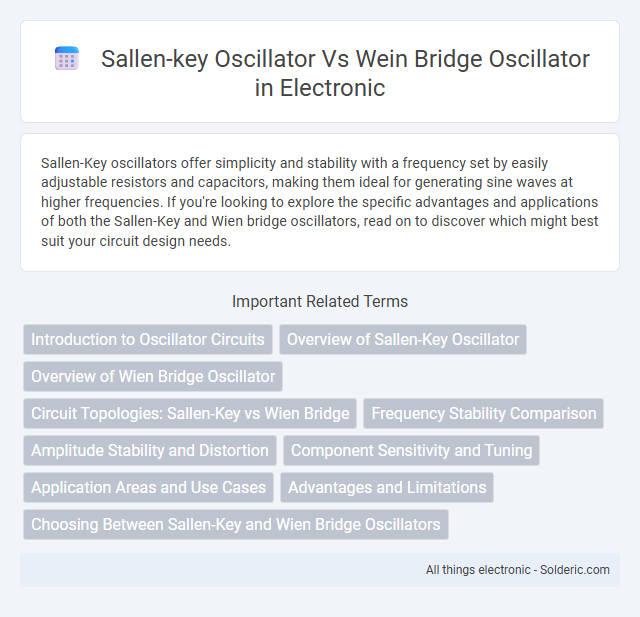Sallen-Key oscillators offer simplicity and stability with a frequency set by easily adjustable resistors and capacitors, making them ideal for generating sine waves at higher frequencies. If you're looking to explore the specific advantages and applications of both the Sallen-Key and Wien bridge oscillators, read on to discover which might best suit your circuit design needs.
Comparison Table
| Feature | Sallen-Key Oscillator | Wein Bridge Oscillator |
|---|---|---|
| Oscillator Type | Active RC oscillator | Active RC oscillator |
| Frequency Stability | Moderate stability | High stability with amplitude control |
| Amplitude Control | Limited or none | Automatic amplitude stabilization using non-linear elements (e.g., bulbs, diodes) |
| Frequency Range | Up to MHz range | Typically audio frequency range (Hz to kHz) |
| Complexity | Simple circuit design | More complex due to amplitude stabilization circuitry |
| Waveform Output | Sine wave, may require filtering | Pure sine wave output |
| Applications | Signal generation, filters, audio oscillators | Audio oscillators, precise frequency generation |
| Common Components | Operational amplifier, resistors, capacitors | Operational amplifier, resistors, capacitors, amplitude control element |
Introduction to Oscillator Circuits
Sallen-Key and Wien Bridge oscillators are popular oscillator circuits used for generating stable sinusoidal waveforms in electronic systems. Sallen-Key oscillators utilize active filters and operational amplifiers to achieve frequency-selective feedback, making them suitable for a wide range of frequencies with relative simplicity. Your choice between the two depends on factors like required frequency stability and harmonic distortion, with Wien Bridge oscillators typically excelling in low-distortion audio frequency generation.
Overview of Sallen-Key Oscillator
The Sallen-Key oscillator is an active electronic oscillator circuit that uses a combination of resistors, capacitors, and an operational amplifier to generate sinusoidal waveforms. It is known for its simple design, frequency stability, and ease of frequency adjustment by varying component values. This oscillator is widely used in audio signal generation and instrumentation due to its low distortion and reliable performance.
Overview of Wien Bridge Oscillator
The Wien Bridge Oscillator generates low-distortion sine waves using a frequency-selective bridge circuit with resistors and capacitors arranged in a lead-lag configuration. It relies on positive feedback through the Wien bridge network and amplitude stabilization via a nonlinear component such as a lamp or diode to maintain stable oscillations. You can achieve precise frequency control and high signal purity with this oscillator, making it ideal for audio frequency generation and testing applications.
Circuit Topologies: Sallen-Key vs Wien Bridge
Sallen-Key oscillators employ an active RC filter topology with operational amplifiers configured for positive feedback to generate sinusoidal signals, utilizing two capacitors and two resistors in the frequency-determining network. Wien Bridge oscillators use a bridged-T network consisting of resistors and capacitors arranged to form a frequency-selective positive feedback loop, typically stabilized by nonlinear amplitude control elements like thermistors or lamps for automatic gain control. The Sallen-Key design offers simplicity and ease of tuning, whereas the Wien Bridge topology provides superior frequency stability and low distortion for audio-frequency oscillator applications.
Frequency Stability Comparison
Sallen-Key oscillators generally offer higher frequency stability due to their simpler feedback network and fewer components sensitive to parameter variations, which reduces frequency drift over time and temperature changes. Wein bridge oscillators rely on a bridge network with amplitude stabilization via nonlinear elements, making them more susceptible to component tolerances and environmental influences that can affect frequency stability. Consequently, for applications demanding precise and consistent oscillation frequency, Sallen-Key configurations are typically preferred over Wein bridge oscillators.
Amplitude Stability and Distortion
Sallen-Key oscillators typically provide better amplitude stability due to their simpler feedback network, reducing distortion in the output waveform. Wien bridge oscillators rely on amplitude stabilization methods like incandescent bulbs or automatic gain control, which can introduce slight nonlinearities and distortion. Your choice depends on prioritizing low distortion with stable amplitude (Sallen-Key) or smoother amplitude control with potential minor distortion (Wien bridge).
Component Sensitivity and Tuning
The Sallen-Key oscillator exhibits lower component sensitivity, making it more robust against variations in resistors and capacitors, which results in easier tuning and more stable frequency output. In contrast, the Wein bridge oscillator is highly sensitive to component tolerances, requiring precise components and often automatic amplitude control circuits to maintain stable oscillations. Your choice depends on whether ease of tuning or frequency stability under varying conditions is more critical for the application.
Application Areas and Use Cases
Sallen-Key oscillators are widely used in audio signal generation, active filter circuits, and function generators due to their simplicity and ease of frequency tuning. Wien bridge oscillators excel in producing low-distortion sine waves for audio testing, instrumentation, and precise analog signal generation in laboratories. Both oscillator types serve critical roles in communications, waveform synthesis, and sensor excitation, with Sallen-Key favoring versatility and Wien bridge emphasizing signal purity.
Advantages and Limitations
The Sallen-Key oscillator offers simplicity and ease of design with fewer components, making it highly stable for generating sine waves at high frequencies, but it is sensitive to component tolerance, which can affect frequency accuracy. The Wein Bridge oscillator provides excellent frequency stability and low distortion due to its use of amplitude stabilization techniques, though it requires more complex circuitry and careful adjustment of feedback to avoid distortion or amplitude drift. Your choice depends on whether you prioritize straightforward implementation (Sallen-Key) or precision and low harmonic distortion (Wein Bridge) in oscillator applications.
Choosing Between Sallen-Key and Wien Bridge Oscillators
Choosing between Sallen-Key and Wien Bridge oscillators depends on your application's frequency stability and complexity requirements. Sallen-Key oscillators offer simpler design and easier frequency tuning, ideal for fixed-frequency signals with moderate precision. Wien Bridge oscillators provide superior frequency stability and lower distortion, making them suitable for audio and precise waveform generation in your projects.
sallen-key oscillator vs wein bridge oscillator Infographic

 solderic.com
solderic.com